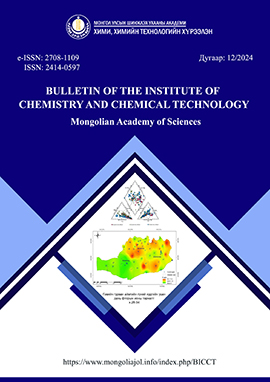Research on reducing the iron minerals in the ash of thermal power plant ash ponds
DOI:
https://doi.org/10.5564/bicct.v12i12.3937Keywords:
pond ash, iron, magnetic separation, acid leachingAbstract
This study investigates technological solutions for reducing the iron content in fly ash, a byproduct generated in large quantities during coal combustion at thermal power plants. The fly ash used in the study contained 45.5% SiO2, 11.3% Al2O3, and 12.5% Fe2O3. Fly ash has been traditionally utilized in construction materials, road and bridge development, and zeolite synthesis. However, recent advancements focus on extracting silica (SiO2) and alumina (Al2O3) from fly ash for applications in energy storage, 3D printing, and composite materials. The presence of iron oxides in fly ash hinders the production of these compounds with high purity, negatively impacting product quality. The study compares two methods for reducing iron content in fly ash. Initially, unburned carbon in the fly ash was removed through thermal treatment at 800°C for 2 hours. Subsequently, wet magnetic separation and acid leaching using an autoclave were employed to reduce iron content. Wet magnetic separation (at a magnetic field strength of 400 mT) removed 51.0% of the total iron content. Acid leaching with hydrochloric acid (HCl) under optimized conditions (6M HCl, 24 hours, 100°C, solid-to-liquid ratio of 1:10) achieved a 91.4% reduction in iron content. The results demonstrate that effective reduction of iron content in fly ash facilitates the extraction of high-purity silica and alumina, enabling their application in advanced technology sectors such as catalysis, energy storage, and electronics manufacturing.
Дулааны цахилгаан станцын үнсэн сангийн үнсний төмрийн агуулгыг бууруулах судалгаа
Энэхүү судалгаагаар дулааны цахилгаан станцад нүүрс шатаах явцад их хэмжээгээр үүсдэг хаягдал үнсний төмрийн агуулгыг бууруулах технологийн шийдлүүдийг харьцуулан судалсан. Судалгаанд ашигласан үнс нь 45.5% SiO2, 11.3% Al2O3, 12.5% Fe2O3 агуулгатай байсан. Хаягдал үнсийг барилгын материал, зам гүүрийн бүтээн байгуулалт, цеолитын нийлэгжилтэд ашигласаар ирсэн бөгөөд орчин үед үнснээс цахиурын давхар оксид (SiO2), хөнгөнцагаан (Al2O3)-ыг ялган авч, цэнэг хураагуур, 3D хэвлэл, нийлмэл материал гарган авах судалгаа өргөжиж байна. Гэвч үнсэнд агуулагдах төмрийн оксид нь эдгээр нэгдлүүдийг өндөр цэвэршилттэй гарган авахад саад болж, бүтээгдэхүүний чанарт сөрөг нөлөө үзүүлдэг. Судалгааны ажлаар үнснээс төмрийн агуулгыг бууруулах хоёр төрлийн боловсруулалтын аргыг харьцуулсан. Үнсэнд агуулагдах дутуу шатсан нүүрстөрөгчийг дулааны боловсруулалт хийж (800°C, 2 цаг) бүрэн зайлуулсны дараа нойтон соронзон баяжуулалт болон хүчлийн автоклавын уусгалтын аргыг ашиглан төмрийн агуулгыг бууруулах боломжийг судалсан. Нойтон соронзон баяжуулалтын аргаар (соронзон хүч 400мТл) нийт төмрийн 51.0%-ийг зайлуулсан бол давсны хүчил (HCl) ашиглан автоклавын уусгалтын аргаар төмрийг зайлуулах тохиромжтой параметрийг (6М HCl, 24 цаг, 100°C, Х:Ш харьцаа 1:10) тодорхойлж, төмрийн агуулгыг 91.4% хүртэл бууруулах боломжтойг тогтоов. Судалгааны үр дүнд үнсэн дэх төмрийн агуулгыг үр дүнтэйгээр бууруулснаар цахиур болон хөнгөнцагааны оксидуудыг өндөр цэвэршилттэй гарган авах боломжийг бүрдүүлж байна.
Түлхүүр үг: хаягдал үнс, төмөр, соронзон баяжуулалт, хүчлийн уусгалт
Downloads
335
Downloads
Published
How to Cite
Issue
Section
License
Copyright (c) 2024 Luvsandagva Mandakhsaikhan, Batmunkh Davaabal, Rentsennorov Ulambayar, Ochirkhuyag Altantuya, Tsoodol Zolzaya, Gendenjamts Oyun-Erdene

This work is licensed under a Creative Commons Attribution 4.0 International License.
Copyright on any research article in the Bulletin of the Institute of Chemistry and Chemical Technology, MAS is retained by the author(s).
The authors grant the Bulletin of the Institute of Chemistry and Chemical Technology, MAS a license to publish the article and identify itself as the original publisher.

Articles in the Bulletin of the Institute of Chemistry and Chemical Technology, MAS are Open Access articles published under a Creative Commons Attribution 4.0 International License CC BY.
This license permits use, distribution and reproduction in any medium, provided the original work is properly cited.

